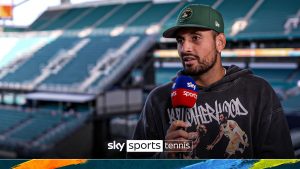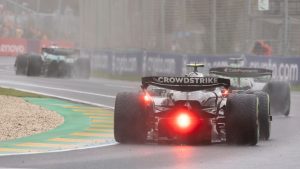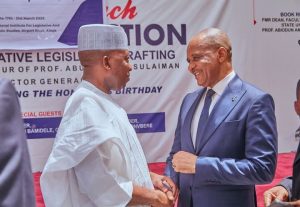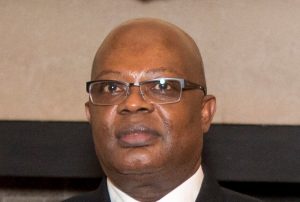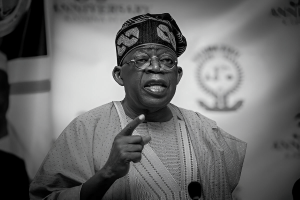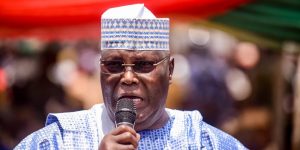MLB Draft 2022: What to know about every first-round pick
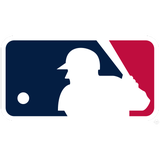

By Jake Mintz
FOX Sports MLB Writer
Sunday night’s MLB Draft was a spectacle. Held outside in Downtown Los Angeles as part of this week’s All-Star festivities, the draft had its fair share of twists and turns as more than 80 picks were made over the first few rounds.
Here’s what you need to know about all 30 of the 2022 first-round picks.
Note: The MLB Draft can be a bit confusing and complicated. What does “overslot” mean? Why don’t players get drafted exactly in talent order? For a refresher on the format and structure of the draft, check out the video below, which explains everything you need to know.
1. Baltimore Orioles: Jackson Holliday, SS, Stillwater High School (OK)
Holliday is the eldest son of seven-time MLB All-Star Matt Holliday and the nephew of Oklahoma State head baseball coach Josh Holliday.
Jackson, who has long, blond “Fabio” hair, rocketed up draft boards this spring after he posted a comically good .685/.752/1.392 slash line with 17 homers. That power potential, plus a track record of superb swing decision-making and the high likelihood that he sticks at shortstop, will make Jackson a top-50 prospect the second he signs.
While Holliday was a consensus top-three talent in this draft, the Orioles probably selected him over Druw Jones because Holliday was willing to eventually sign for less money. It’s not just penny-pinching, though; the Orioles will likely use some of the “savings” to draft players with their later picks that they wouldn’t otherwise be able to sign.
2. Arizona Diamondbacks: Druw Jones, OF, Wesleyan School (GA)
The son of former Braves superstar Andruw Jones, Druw was considered the best talent in this draft by most prognosticators. Just like his pops, he’s an elite defender in center field, and he took huge steps forward at the plate during his high school season in 2022. There’s real power here, rapidly improving bat-to-ball skills and a long history of crushing it against great competition on the summer travel ball circuit.
Druw is already a huge deal on social media. He’s a household name among most internet-savvy little leaguers and already has more Instagram followers than Byron Buxton, the dude starting in center field for the American League in Tuesday’s All-Star Game.
3. Texas Rangers: Kumar Rocker, SP, Tri-City ValleyCats
Rocker was taken 10th overall by the Mets in last year’s draft, but he ended up not signing with the club after New York’s front office had concerns about his medical after his velocity dipped in his last few starts. That forced Rocker to sit out the 2022 spring season — no, it’s not fair — and reenter the draft this go-around.
In his three years at Vanderbilt, Rocker became one of the most famous college players in recent memory. He hopped into the larger baseball consciousness after a 17-strikeout no-hitter his freshman year.
His selection at No. 3 was easily the shock of the draft. Most people thought he’d go in the middle to back of the first round. Instead, Rocker will reunite in the Texas farm system with his college rotation mate and last year’s No. 2 overall pick, Jack Leiter.
4. Pittsburgh Pirates: Termarr Johnson, 2B, Mays High School (GA)
Johnson had a lot of buzz at No. 1 overall but fell to the Pirates, who are understandably stoked about adding the best pure hitter in this class.
Rather than play his high school ball at any of the many premier private school programs in the Atlanta area, Johnson opted to stay at Mays, where his older brothers went and where he felt a meaningful connection with the school community.
Listed at 5-foot-10, Johnson is probably closer to 5-foot-8, but he has outstanding power potential at the plate, thanks to a strong lower half.
5. Washington Nationals: Elijah Green, OF, IMG Academy (FL)
Green is a mountain of a man with star-scraping power who runs like a gazelle and is likely to stay in center field going forward. Elijah’s dad, Terry Green, was a two-time pro bowl tight end for the Baltimore Ravens.
Why didn’t Green go first overall? Some teams were concerned about his swing-and-miss tendency and skeptical that he’d make enough contact at the next level.
6. Miami Marlins: Jacob Berry, 1B, LSU
Considered the best college hitter in this class, Berry combines phenomenal power from both sides of the plate with great contact abilities. Think Spencer Torkelson or Andrew Vaughn.
Berry transferred to LSU after an awesome freshman season at Arizona, after which his skipper at U of A, Jay Johnson, took the head job in Baton Rouge.
Defensively, Berry is a bit of a disaster. At LSU, he played some third and some left and also DHed a bit because the Tigers had an elite defensive first baseman. Moving forward, he’ll likely stick at first.
7. Chicago Cubs: Cade Horton, SP, Oklahoma
If you want the whole story, read this article, but Horton’s rise from injured freshman to top-10 pick was downright remarkable.
Last month, he turned in two outstanding starts for the Sooners in the College World Series, as Oklahoma finished runners-up in Omaha. A two-sport prospect in high school, Horton was set to play quarterback for Oklahoma but dropped football completely upon arriving to campus.
8. Minnesota Twins: Brooks Lee, SS, Cal Poly
Lee had a bit of buzz at first overall, but once the Orioles passed on him (potentially due to concerns about a back injury), the connection between the switch-hitting infielder and the Twins was pretty strong. This pick wasn’t a big shock.
Brooks’ dad, Larry, was his head coach at Cal Poly.
Even if Lee doesn’t stay at shortstop in pro ball, he’s a lock to be a good defensive third baseman.
9. Kansas City Royals: Gavin Cross, OF, Virginia Tech
Cross was a key part of Virginia Tech’s super-regional run this season and paced the Hokies with 17 homers and a 1.071 OPS.
At Virginia Tech, Cross played mostly center field, but he isn’t a sure bet to stay there moving forward. If he moves to a corner, he’ll be good out there.
10. Colorado Rockies: Gabriel Hughes, SP, Gonzaga
Most mock drafts had Hughes projected later than this, but the Rockies surprised by taking the 6-foot-5 righty 10th overall.
Hughes starred for Gonzaga but fell off a bit down the stretch. He’s more likely to be a mid-rotation arm than a frontline monster.
11. New York Mets: Kevin Parada, C, Georgia Tech
Parada was projected to land as high as the top five, so this looks like a steal for the Mets, who bungled their draft last year.
The best catcher in college baseball this year, Parada is another in a long line of notable backstops from Georgia Tech that includes Matt Wieters and Joey Bart. Go watch some video of Parada’s swing. He has a pretty weird setup and load but magnificent power.
12. Detroit Tigers: Jace Jung, INF, Texas Tech
Jung has been one of college baseball’s most consistent and feared sluggers the past three seasons, despite a bizarre pre-swing setup in the mold of Rod Carew or Jason Kipnis.
Jace’s brother, Josh, also went to Texas Tech, was also a high draft pick and had a similar profile to Jace.
Jung’s defensive future is murky. His bat should allow him to play anywhere, but he’s certainly not a great glove.
13. Los Angeles Angels: Zach Neto, SS, Campbell
Neto’s calling card is an outrageously large leg kick that, when you freeze-frame it, looks more like a pitcher working toward home. Even though there’s some doubt about whether that massive leg kick will work against pro velocity, evaluators believe in Neto’s bat-to-ball skills.
Campbell had another top pick, starting pitcher Thomas Harrington, who went 36th overall to the Pirates.
14. New York Mets: Jett Williams, SS, Rockwall Heath High School (TX)
Williams is built like an NFL running back (think Maurice Jones-Drew) but should still be able to stick at shortstop.
Because the Mets failed to sign Rocker last year, they had two picks in the first round this year and took a pretty straightforward approach by selecting Williams, who should sign despite a commitment to Mississippi State.
15. San Diego Padres: Dylan Lesko, SP, Buford High School (GA)
Lesko was the consensus top high school arm in the draft and was slated for the top five picks before he tore his UCL this spring and required Tommy John surgery.
The separator for Lesko is a devastating changeup, a pitch few high school pitchers have great feel for.
16. Cleveland Guardians: Chase DeLauter, OF, James Madison University
James Madison is certainly not a college baseball powerhouse — the program hasn’t produced a big leaguer since 2013 — but DeLauter was able to catch scouts’ eyes, thanks to a superb summer season in the Cape Cod League.
DeLauter is a likely right fielder at the next level, and he should hit enough to rise up the Guardians’ system. He’s a prototypical college corner-outfield power bat, except for the fact that he didn’t play great competition in college.
17. Philadelphia Phillies: Justin Crawford, OF, Bishop Gorman High School (NV)
The son of former big-league All-Star Carl Crawford, Justin also has blazing, top-of-the-charts speed on the basepaths.
At the plate, he has a bit more power potential than his pops did, but he also has big swing-and-miss risk, perhaps the most in this class.
18. Cincinnati Reds: Cam Collier, 3B, Chipola Junior College
At just 17, Collier was the youngest first-round pick in more than a decade after he graduated high school after his sophomore year and enrolled in a premier junior college.
Collier’s falling this far was a substantial surprise and initiated rumors that he might not sign and might instead honor his commitment to Louisville. The Reds will likely need to pay him overslot if they want to sign him.
19. Oakland Athletics: Daniel Susac, C, University of Arizona
Susac’s older brother, Andrew, also played at Arizona and spent some time in the big leagues with the Giants.
Daniel is a good but not great defender who is more of a Mike Zunino-style power catcher than an Alejandro Kirk-style, contact-oriented backstop.
20. Atlanta Braves: Owen Murphy, SP, Riverside-Brookfield High School (IL)
Murphy is your stereotypical high school pitching prospect with a good heater in the low 90s and two good offspeed offerings.
He’s committed to Notre Dame, a program that hasn’t historically had many high school talents of his caliber. Even though he would be a two-way player at Notre Dame, he’ll be a pitcher only with the Braves.
21. Seattle Mariners: Cole Young, SS, North Allegheny High School (PA)
Young is not flashy, he is not electric, and his tools are not loud, but the guy is a “baseball player” — whatever that means. The sum is greater than the parts. He is also about as safe as a cold-weather high school hitter can be.
22. St. Louis Cardinals: Cooper Hjerpe, SP, Oregon State
Hjerpe was the best pitcher — statistically, at least — in college baseball this season.
He throws from a Chris Sale/Josh Hader/Randy Johnson-style low, lefty arm slot, but it’s somehow even weirder and more difficult for hitters to pick up. His raw stuff isn’t nearly as nasty as those other guys’, though.
23. Toronto Blue Jays: Brandon Barriera, SP, American Heritage School (FL)
Barriera is a loose, athletic, fluid lefty with great feel to pitch who sat out the last few starts of his senior high school season to avoid injury and maintain his draft stock.
Some scouts hated that move and thought it amounted to abandoning his team; others appreciated the pragmatism of the decision.
24. Boston Red Sox: Mikey Romero, SS, Orange Lutheran High School (CA)
Romero lacks current strength, and some evaluators are skeptical that he’ll ever develop power potential, but he’s a seasoned, defensive shortstop who makes a lot of contact and has a really visually pleasing swing.
His two sisters, Sierra and Sydney, were both All-American softball players and are considered two of the sport’s GOATs.
Zero mock drafts had Romero going in the first round, and his selection here was definitely a surprise. But the Red Sox did a similar zag in 2020, when they selected infielder Nick Yorke ahead of where anyone thought he’d go, and Yorke is now considered a top-100 prospect.
25. New York Yankees: Spencer Jones, OF, Vanderbilt University
At 6-foot-7, Jones draws obvious comparisons to Yankees slugger Aaron Judge. Just read this.
26. Chicago White Sox: Noah Schultz, SP, Oswego East High School (IL)
Schultz is long and lean in sort of a “Mike Teevee from Willy Wonka” type way, but he throws from a pretty low slot.
He didn’t pitch a whole lot this year because of injuries, so there’s a decent chance he could honor his commitment to Vanderbilt if he doesn’t get the money he’s looking for.
27. Milwaukee Brewers: Eric Brown Jr., SS, Coastal Carolina
Brown is an athletic college shortstop with a big swing and the potential to blossom into a really impactful hitter. He’s also a great defender at short.
He has a huge leg kick and bizarre hand load, but hey, it works for him.
28. Houston Astros: Drew Gilbert, CF, University of Tennessee
Gilbert was the face, heart and soul of a must-see Volunteers team that made history and viral moments galore.
Gilbert is a short but tightly wound and powerful athlete with a compact swing, real power and the speed to play center field. Also, nobody has worn this much eye black since Bryce Harper was in high school.
29. Tampa Bay Rays: Xavier Isaac, 1B, East Forsyth High School (NC)
Isaac is an enormous high school hitter with tremendous raw power. It was definitely a bit of a surprise that he snuck into the first round, considering that he missed all of last summer, his crucial pre-draft showcase summer, due to an injury that kept most scouts from getting eyeballs on him.
30. San Francisco Giants: Reggie Crawford, two-way player, UConn
Crawford has a wild story. He was primarily a hitter — big swing, big dude, big power, corresponding strikeout issues — until last summer, when the lefty started throwing high 90s off the mound for Team USA. But before he could solidify himself as a top pick, Crawford tore his UCL, got Tommy John surgery and missed the entire season.
This is a great, high-upside pick by the Giants, who snag the type of talent that isn’t usually available with the last pick of the first round of the MLB Draft. Most evaluators think Crawford’s future is on the mound, but it’s telling that San Francisco announced him as a two-way player. His power is so rad that it makes sense to let him hit for a bit, even if the organization ends up taking his bat away at some point down the road.
Jake Mintz is the louder half of @CespedesBBQ and a baseball writer for FOX Sports. He’s an Orioles fan living in New York City, and thus, he leads a lonely existence most Octobers. If he’s not watching baseball, he’s almost certainly riding his bike. You can follow him on Twitter @Jake_Mintz.
Get more from Major League Baseball Follow your favorites to get information about games, news and more.


